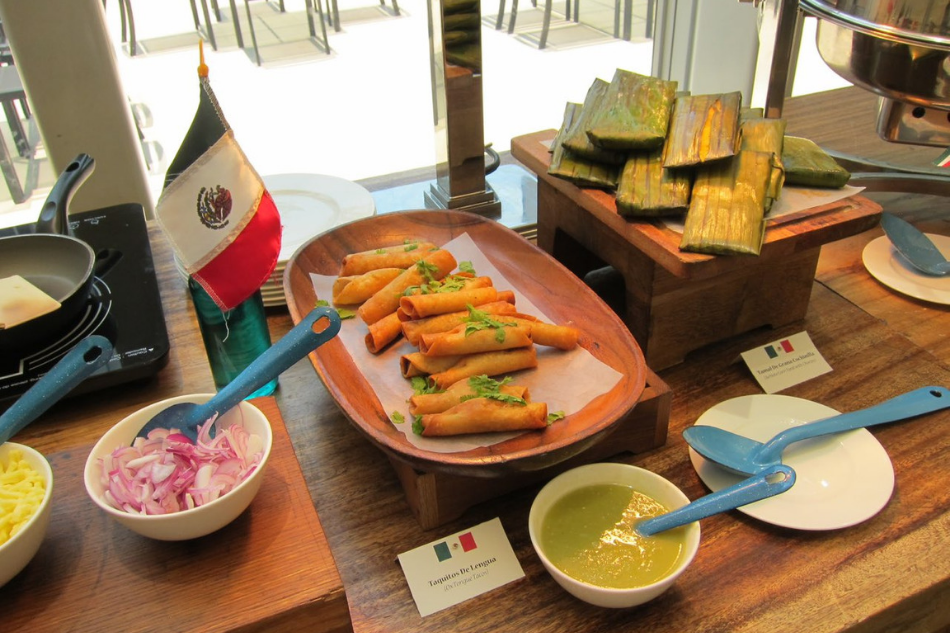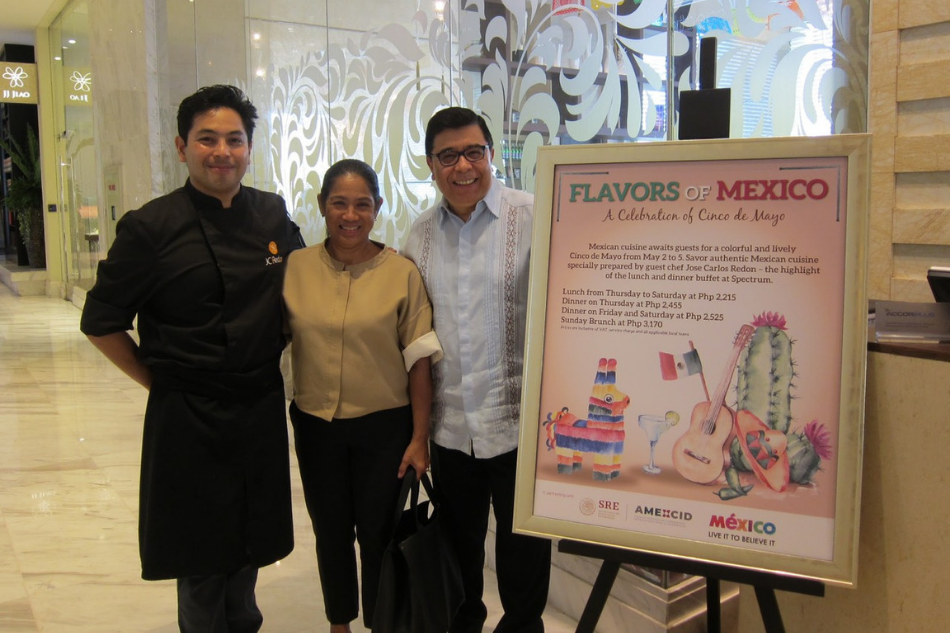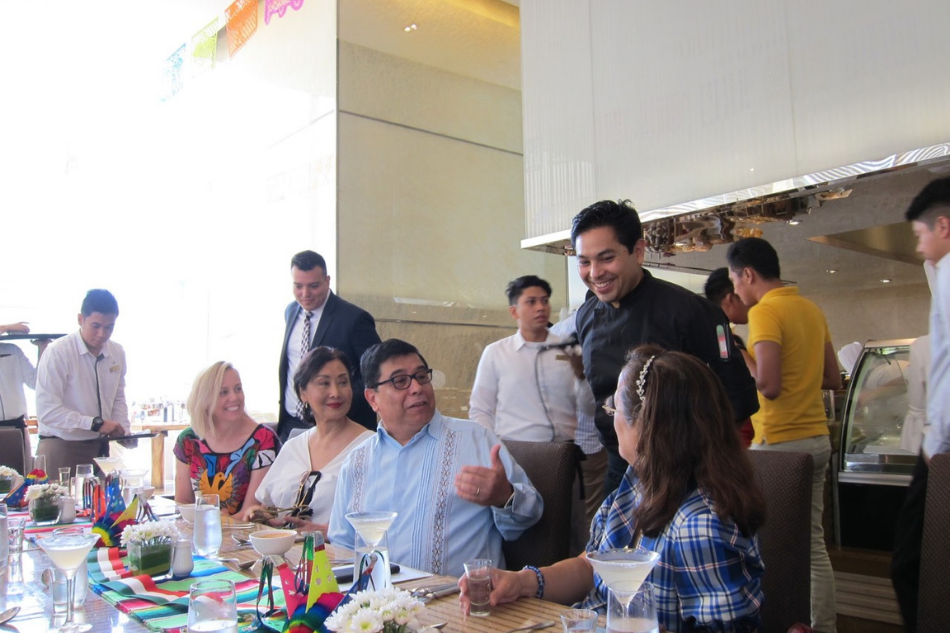Cactus salad and toasted grasshopper—but no enchiladas—at this Mexican fest in Makati | ABS-CBN
ADVERTISEMENT

Welcome, Kapamilya! We use cookies to improve your browsing experience. Continuing to use this site means you agree to our use of cookies. Tell me more!
Cactus salad and toasted grasshopper—but no enchiladas—at this Mexican fest in Makati
Cactus salad and toasted grasshopper—but no enchiladas—at this Mexican fest in Makati
Andrew Paredes
Published May 07, 2019 01:31 PM PHT
|
Updated May 07, 2019 05:57 PM PHT
If cuisine is the calling card of a culture, then Mexican culture would be one of the most popular networkers around. After Italian and Japanese, Mexican is the most exported cuisine in the world.
If cuisine is the calling card of a culture, then Mexican culture would be one of the most popular networkers around. After Italian and Japanese, Mexican is the most exported cuisine in the world.
And yet Mexico barely has a presence in the Philippine culinary scene, which is strange given how enmeshed the two countries’ histories and cultures are. Spain ruled the Philippines for centuries through the Viceroy of Mexico, and there is an argument to be made that the Spaniards colonized us by name only: folk Catholicism as a means of propagating Christianity, the architecture of our churches and the layout of our rural towns, even such minutiae as Puerto Galera being a storm-proof dock for galleons—all are living connections to our Latin American brethren.
And yet Mexico barely has a presence in the Philippine culinary scene, which is strange given how enmeshed the two countries’ histories and cultures are. Spain ruled the Philippines for centuries through the Viceroy of Mexico, and there is an argument to be made that the Spaniards colonized us by name only: folk Catholicism as a means of propagating Christianity, the architecture of our churches and the layout of our rural towns, even such minutiae as Puerto Galera being a storm-proof dock for galleons—all are living connections to our Latin American brethren.
You may also like:
You may also like:
In line with the Cinco de Mayo celebrations this weekend, the Embassy of Mexico launched a buffet named “Flavors of Mexico” at the all-day dining restaurant Spectrum in the Raffles Makati via a luncheon attended by such personalities as renowned chef Margarita Fores and ex-Tourism Secretary Gemma Cruz-Araneta (herself a former longtime resident of Mexico City). Spearheaded by Mexican Ambassador Gerardo Lozano Arredondo and globetrotting chef Jose Carlos Redon, “Flavors of Mexico” is a deep dive into Mexican cuisine beyond the usual staples of tacos and nachos.
In line with the Cinco de Mayo celebrations this weekend, the Embassy of Mexico launched a buffet named “Flavors of Mexico” at the all-day dining restaurant Spectrum in the Raffles Makati via a luncheon attended by such personalities as renowned chef Margarita Fores and ex-Tourism Secretary Gemma Cruz-Araneta (herself a former longtime resident of Mexico City). Spearheaded by Mexican Ambassador Gerardo Lozano Arredondo and globetrotting chef Jose Carlos Redon, “Flavors of Mexico” is a deep dive into Mexican cuisine beyond the usual staples of tacos and nachos.
ADVERTISEMENT
There was nary an enchilada in sight at the luncheon. There was cactus salad, vegetable rice, seared snapper, and a variety of dishes served in clay pots. There were impromptu tutorials from cultural attaché Gerardo Regalado on how to hold and eat soft tacos so the fillings don’t dribble down your shirt, fascinating stories from Gemma Cruz-Araneta about errant Filipino painters living the expat life in Mexico, and explanations of why the smoky, chest-warming liqueur mezcal is such a perfect complement to citrus-drizzled carnitas.
There was nary an enchilada in sight at the luncheon. There was cactus salad, vegetable rice, seared snapper, and a variety of dishes served in clay pots. There were impromptu tutorials from cultural attaché Gerardo Regalado on how to hold and eat soft tacos so the fillings don’t dribble down your shirt, fascinating stories from Gemma Cruz-Araneta about errant Filipino painters living the expat life in Mexico, and explanations of why the smoky, chest-warming liqueur mezcal is such a perfect complement to citrus-drizzled carnitas.
More interestingly, globetrotting chef JC Redon illustrated the history of struggle that is one of the backbones of Mexican cuisine. Chef JC—who counts a farm that cultivates and supplies ant eggs to Mexico’s finest eateries as one of his businesses—talked about the barbacoa, the process of steaming whole meats by putting them in a hole in the ground and covering them with maguey leaves. Barbacoa is most often practiced in the more arid, inhospitable regions of the country, and that opener led to a thread in the conversation on Ilocano cuisine, which was also born in a dry region of the country.
More interestingly, globetrotting chef JC Redon illustrated the history of struggle that is one of the backbones of Mexican cuisine. Chef JC—who counts a farm that cultivates and supplies ant eggs to Mexico’s finest eateries as one of his businesses—talked about the barbacoa, the process of steaming whole meats by putting them in a hole in the ground and covering them with maguey leaves. Barbacoa is most often practiced in the more arid, inhospitable regions of the country, and that opener led to a thread in the conversation on Ilocano cuisine, which was also born in a dry region of the country.
One of the more exotic offerings during the luncheon was chapulines, toasted grasshopper usually served with garlic, lime and salt, but which chef JC dressed up in guacamole and soft tacos. The guacamole served as a cushion for finicky palates, yet the whole panoply of sour-spicy-salty flavors remained intact. Chef JC quipped that importing chapolin is itself a struggle; not only are they harvested during a narrow window every year (roughly early May until late summer), but getting the insects through customs provided some suspense.
One of the more exotic offerings during the luncheon was chapulines, toasted grasshopper usually served with garlic, lime and salt, but which chef JC dressed up in guacamole and soft tacos. The guacamole served as a cushion for finicky palates, yet the whole panoply of sour-spicy-salty flavors remained intact. Chef JC quipped that importing chapolin is itself a struggle; not only are they harvested during a narrow window every year (roughly early May until late summer), but getting the insects through customs provided some suspense.
But the dish I was most looking forward to was chicken in mole sauce. Mole—or specifically, mole poblano, the popular version whose dark brown hue comes from the addition of cocoa to chili and various spices—is such an emblem of Mexico that the regions of Oaxaca and Puebla both claim credit for inventing it. Its origins—depending on which apocryphal version you believe—are also rooted in necessity. One legend has the poor nuns of Santa Clara Convent in Puebla combining the little bits from their bare cupboard in a burst of divine inspiration, then slathering the resulting mixture over turkey for a visiting archbishop.
But the dish I was most looking forward to was chicken in mole sauce. Mole—or specifically, mole poblano, the popular version whose dark brown hue comes from the addition of cocoa to chili and various spices—is such an emblem of Mexico that the regions of Oaxaca and Puebla both claim credit for inventing it. Its origins—depending on which apocryphal version you believe—are also rooted in necessity. One legend has the poor nuns of Santa Clara Convent in Puebla combining the little bits from their bare cupboard in a burst of divine inspiration, then slathering the resulting mixture over turkey for a visiting archbishop.
I had mole twice during a trip to Mexico City seven years ago. Once bare and unadorned with a soft tortilla at a hole-in-the-wall eatery during a street food tour; and then again at world-renowned restaurant Pujol in the chi chi Polanco district, where it had been aged for more than 200 days. I have never forgotten its deep, full flavor, and chef JC’s rendition brought back warm memories of that momentous trip.
I had mole twice during a trip to Mexico City seven years ago. Once bare and unadorned with a soft tortilla at a hole-in-the-wall eatery during a street food tour; and then again at world-renowned restaurant Pujol in the chi chi Polanco district, where it had been aged for more than 200 days. I have never forgotten its deep, full flavor, and chef JC’s rendition brought back warm memories of that momentous trip.
More importantly, it brought home the truth that the exotic is really a roundabout way to get to know that which is familiar. After all, there may be much in food that is foreign to us, but really there is more in it that binds us.
More importantly, it brought home the truth that the exotic is really a roundabout way to get to know that which is familiar. After all, there may be much in food that is foreign to us, but really there is more in it that binds us.
“Flavors of Mexico” is ongoing at Spectrum, Raffles Makati, 1 Raffles Drive, Makati City. Call (02) 555-9840 for reservations.
ADVERTISEMENT
ADVERTISEMENT







